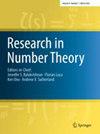D. R. Johnston, O. Ramaré, T. Trudgian
求助PDF
{"title":"当$$\\chi $$是二次元时,$$L(1,\\chi )$$的显式上界","authors":"D. R. Johnston, O. Ramaré, T. Trudgian","doi":"10.1007/s40993-023-00476-4","DOIUrl":null,"url":null,"abstract":"Abstract We consider Dirichlet L -functions $$L(s, \\chi )$$ <mml:math xmlns:mml=\"http://www.w3.org/1998/Math/MathML\"> <mml:mrow> <mml:mi>L</mml:mi> <mml:mo>(</mml:mo> <mml:mi>s</mml:mi> <mml:mo>,</mml:mo> <mml:mi>χ</mml:mi> <mml:mo>)</mml:mo> </mml:mrow> </mml:math> where $$\\chi $$ <mml:math xmlns:mml=\"http://www.w3.org/1998/Math/MathML\"> <mml:mi>χ</mml:mi> </mml:math> is a non-principal quadratic character to the modulus q . We make explicit a result due to Pintz and Stephens by showing that $$|L(1, \\chi )|\\leqslant \\frac{1}{2}\\log q$$ <mml:math xmlns:mml=\"http://www.w3.org/1998/Math/MathML\"> <mml:mrow> <mml:mrow> <mml:mo>|</mml:mo> <mml:mi>L</mml:mi> <mml:mrow> <mml:mo>(</mml:mo> <mml:mn>1</mml:mn> <mml:mo>,</mml:mo> <mml:mi>χ</mml:mi> <mml:mo>)</mml:mo> </mml:mrow> <mml:mo>|</mml:mo> </mml:mrow> <mml:mo>⩽</mml:mo> <mml:mfrac> <mml:mn>1</mml:mn> <mml:mn>2</mml:mn> </mml:mfrac> <mml:mo>log</mml:mo> <mml:mi>q</mml:mi> </mml:mrow> </mml:math> for all $$q\\geqslant 2\\cdot 10^{23}$$ <mml:math xmlns:mml=\"http://www.w3.org/1998/Math/MathML\"> <mml:mrow> <mml:mi>q</mml:mi> <mml:mo>⩾</mml:mo> <mml:mn>2</mml:mn> <mml:mo>·</mml:mo> <mml:msup> <mml:mn>10</mml:mn> <mml:mn>23</mml:mn> </mml:msup> </mml:mrow> </mml:math> and $$|L(1, \\chi )|\\leqslant \\frac{9}{20}\\log q$$ <mml:math xmlns:mml=\"http://www.w3.org/1998/Math/MathML\"> <mml:mrow> <mml:mrow> <mml:mo>|</mml:mo> <mml:mi>L</mml:mi> <mml:mrow> <mml:mo>(</mml:mo> <mml:mn>1</mml:mn> <mml:mo>,</mml:mo> <mml:mi>χ</mml:mi> <mml:mo>)</mml:mo> </mml:mrow> <mml:mo>|</mml:mo> </mml:mrow> <mml:mo>⩽</mml:mo> <mml:mfrac> <mml:mn>9</mml:mn> <mml:mn>20</mml:mn> </mml:mfrac> <mml:mo>log</mml:mo> <mml:mi>q</mml:mi> </mml:mrow> </mml:math> for all $$q\\geqslant 5\\cdot 10^{50}$$ <mml:math xmlns:mml=\"http://www.w3.org/1998/Math/MathML\"> <mml:mrow> <mml:mi>q</mml:mi> <mml:mo>⩾</mml:mo> <mml:mn>5</mml:mn> <mml:mo>·</mml:mo> <mml:msup> <mml:mn>10</mml:mn> <mml:mn>50</mml:mn> </mml:msup> </mml:mrow> </mml:math> .","PeriodicalId":43826,"journal":{"name":"Research in Number Theory","volume":"201 1","pages":"0"},"PeriodicalIF":0.8000,"publicationDate":"2023-10-03","publicationTypes":"Journal Article","fieldsOfStudy":null,"isOpenAccess":false,"openAccessPdf":"","citationCount":"0","resultStr":"{\"title\":\"An explicit upper bound for $$L(1,\\\\chi )$$ when $$\\\\chi $$ is quadratic\",\"authors\":\"D. R. Johnston, O. Ramaré, T. Trudgian\",\"doi\":\"10.1007/s40993-023-00476-4\",\"DOIUrl\":null,\"url\":null,\"abstract\":\"Abstract We consider Dirichlet L -functions $$L(s, \\\\chi )$$ <mml:math xmlns:mml=\\\"http://www.w3.org/1998/Math/MathML\\\"> <mml:mrow> <mml:mi>L</mml:mi> <mml:mo>(</mml:mo> <mml:mi>s</mml:mi> <mml:mo>,</mml:mo> <mml:mi>χ</mml:mi> <mml:mo>)</mml:mo> </mml:mrow> </mml:math> where $$\\\\chi $$ <mml:math xmlns:mml=\\\"http://www.w3.org/1998/Math/MathML\\\"> <mml:mi>χ</mml:mi> </mml:math> is a non-principal quadratic character to the modulus q . We make explicit a result due to Pintz and Stephens by showing that $$|L(1, \\\\chi )|\\\\leqslant \\\\frac{1}{2}\\\\log q$$ <mml:math xmlns:mml=\\\"http://www.w3.org/1998/Math/MathML\\\"> <mml:mrow> <mml:mrow> <mml:mo>|</mml:mo> <mml:mi>L</mml:mi> <mml:mrow> <mml:mo>(</mml:mo> <mml:mn>1</mml:mn> <mml:mo>,</mml:mo> <mml:mi>χ</mml:mi> <mml:mo>)</mml:mo> </mml:mrow> <mml:mo>|</mml:mo> </mml:mrow> <mml:mo>⩽</mml:mo> <mml:mfrac> <mml:mn>1</mml:mn> <mml:mn>2</mml:mn> </mml:mfrac> <mml:mo>log</mml:mo> <mml:mi>q</mml:mi> </mml:mrow> </mml:math> for all $$q\\\\geqslant 2\\\\cdot 10^{23}$$ <mml:math xmlns:mml=\\\"http://www.w3.org/1998/Math/MathML\\\"> <mml:mrow> <mml:mi>q</mml:mi> <mml:mo>⩾</mml:mo> <mml:mn>2</mml:mn> <mml:mo>·</mml:mo> <mml:msup> <mml:mn>10</mml:mn> <mml:mn>23</mml:mn> </mml:msup> </mml:mrow> </mml:math> and $$|L(1, \\\\chi )|\\\\leqslant \\\\frac{9}{20}\\\\log q$$ <mml:math xmlns:mml=\\\"http://www.w3.org/1998/Math/MathML\\\"> <mml:mrow> <mml:mrow> <mml:mo>|</mml:mo> <mml:mi>L</mml:mi> <mml:mrow> <mml:mo>(</mml:mo> <mml:mn>1</mml:mn> <mml:mo>,</mml:mo> <mml:mi>χ</mml:mi> <mml:mo>)</mml:mo> </mml:mrow> <mml:mo>|</mml:mo> </mml:mrow> <mml:mo>⩽</mml:mo> <mml:mfrac> <mml:mn>9</mml:mn> <mml:mn>20</mml:mn> </mml:mfrac> <mml:mo>log</mml:mo> <mml:mi>q</mml:mi> </mml:mrow> </mml:math> for all $$q\\\\geqslant 5\\\\cdot 10^{50}$$ <mml:math xmlns:mml=\\\"http://www.w3.org/1998/Math/MathML\\\"> <mml:mrow> <mml:mi>q</mml:mi> <mml:mo>⩾</mml:mo> <mml:mn>5</mml:mn> <mml:mo>·</mml:mo> <mml:msup> <mml:mn>10</mml:mn> <mml:mn>50</mml:mn> </mml:msup> </mml:mrow> </mml:math> .\",\"PeriodicalId\":43826,\"journal\":{\"name\":\"Research in Number Theory\",\"volume\":\"201 1\",\"pages\":\"0\"},\"PeriodicalIF\":0.8000,\"publicationDate\":\"2023-10-03\",\"publicationTypes\":\"Journal Article\",\"fieldsOfStudy\":null,\"isOpenAccess\":false,\"openAccessPdf\":\"\",\"citationCount\":\"0\",\"resultStr\":null,\"platform\":\"Semanticscholar\",\"paperid\":null,\"PeriodicalName\":\"Research in Number Theory\",\"FirstCategoryId\":\"1085\",\"ListUrlMain\":\"https://doi.org/10.1007/s40993-023-00476-4\",\"RegionNum\":0,\"RegionCategory\":null,\"ArticlePicture\":[],\"TitleCN\":null,\"AbstractTextCN\":null,\"PMCID\":null,\"EPubDate\":\"\",\"PubModel\":\"\",\"JCR\":\"Q3\",\"JCRName\":\"MATHEMATICS\",\"Score\":null,\"Total\":0}","platform":"Semanticscholar","paperid":null,"PeriodicalName":"Research in Number Theory","FirstCategoryId":"1085","ListUrlMain":"https://doi.org/10.1007/s40993-023-00476-4","RegionNum":0,"RegionCategory":null,"ArticlePicture":[],"TitleCN":null,"AbstractTextCN":null,"PMCID":null,"EPubDate":"","PubModel":"","JCR":"Q3","JCRName":"MATHEMATICS","Score":null,"Total":0}
引用次数: 0
引用
批量引用
An explicit upper bound for $$L(1,\chi )$$ when $$\chi $$ is quadratic
Abstract We consider Dirichlet L -functions $$L(s, \chi )$$ L ( s , χ ) where $$\chi $$ χ is a non-principal quadratic character to the modulus q . We make explicit a result due to Pintz and Stephens by showing that $$|L(1, \chi )|\leqslant \frac{1}{2}\log q$$ | L ( 1 , χ ) | ⩽ 1 2 log q for all $$q\geqslant 2\cdot 10^{23}$$ q ⩾ 2 · 10 23 and $$|L(1, \chi )|\leqslant \frac{9}{20}\log q$$ | L ( 1 , χ ) | ⩽ 9 20 log q for all $$q\geqslant 5\cdot 10^{50}$$ q ⩾ 5 · 10 50 .

 求助内容:
求助内容: 应助结果提醒方式:
应助结果提醒方式:


